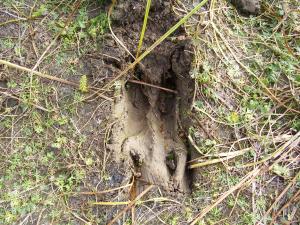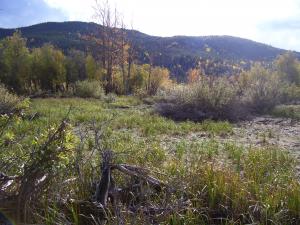Scouting For A Moose Hunt
Scouting for moose is as important to moose hunting, just as pre season scouting is to hunting other animals. The moose is a huge animal (much bigger than the wapiti/elk) averaging well over a thousand pounds. Standing up to seven feet at shoulder height, its front legs are longer than its hind ones. Moose antlers are distinctively different from elk antlers and are shaped like wide sweeping palms with many tines on each antler. A set of mature moose antlers can weigh over sixty pounds.
While scouting for moose, moose tracks are your most prevalent tell there is moose in the area along with other signs like moose droppings, wallow pits, scrapes, rubs and thrashings. The sheer size of moose tracks give it a distinctive character that is easily distinguished from other types of ungulate tracks. Their tracks are heart shaped with the pointed ends facing the direction of travel. The track for each leg is made by two large hoofed toes followed closely by two smaller toes (dew claws). The usual stride of the moose being thirty to forty inches long, the tracks will be found placed accordingly while scouting.

A good sized moose track in northern BC. The track was as long as my boot from tip to dew claw.
Looking at droppings of the moose is another good way to determine moose presence in the vicinity even when the animal not sighted. Similar in shape to chocolate Easter eggs, moose droppings can be differentiated by their light color and larger quantity of fibrous content.
The areas to scout for moose tracks and droppings are marshy places with abundance of aquatic and marshy plants like willows, horsetails and pondweed. These are favored food of the moose. Moose also like to eat lichen, grass and other plants growing on the forest floor, stripping leaves from willows, poplars and sallow with their bottom lip. Peeled off bark adds to the list.
The best time for spotting moose is at dusk or dawn. Moose can usually be spotted along paths and areas where food is available or where they can lick salt on the ground surface or near ponds. If in a vehicle, driving very slowly along a road in moose country can let you spot the animal wading or moving. Make a note of the good locations you find, it will handy during your moose hunt.
Wallow pits made by a bull moose during the rut are another sign of its presence in the area. You can locate these places using your olfactory senses, as the odor will reach you much before you come across the wallow pit. The pits can usually be found in openings where it is easier to remove vegetation as compared to the forest. The bull uses his front hooves and antlers to rake the ground in order to clear vegetation from an area 3 to 4 feet or larger in diameter and then urinates on the exposed earth. Then he lies down and rolls in the muddy urine to coat him with it. This gives to him a pungent smell that cows in heat find appealing. A cow will also roll in the wallow pit made by a bull, as it is an appealing aphrodisiac to them. A wet wallow is an indication of a recent presence of a moose.

I discovered this moose wallowing area in northern BC, The area was covered in tracks and had a nice small pond. I sat there calling for 7 days before a bull moose came in.
As August ends, the velvet tissue completing its work of covering and nurturing the antlers covering the bull’s antlers is ready to be rubbed off. The bull rubs and thrashes his antlers on evergreens and shrubs to rid the antlers of the velvet. This thrashing and rubbing leaves tell tale signs of moose presence and many times, they can be heard beating against the willows and other vegetation with their paddle shaped antlers. The rubs also let the bull deposit his personal scent to attract cows that may wander past. By placing a game-scouting camera where moose presence is probable, you can find out their movements in the area through pictures or video clips.

